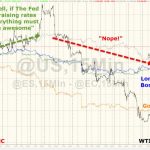The S&P 500 is highly correlated to real wage growth and recent gains in the index may be anticipating faster wage growth under Donald Trump, that’s according to research from analysts at Jefferies.
S&P 500 Is Getting Ready For Real Wage Growth
According to Jefferies’s weekly chart update, when compared to returns of the S&P 500, real wage growth (average hourly earnings minus core CPI) seem to correlate well. However, figures show that although nominal wages have rebounded in the past year and a half, real wages have not which appears to suggest room to move higher for the index limited. That being said, past data also shows that you don’t typically see recessions without real wage growth first exceeding 1%.
There is a past precedent for such a move. In the mid-80s the S&P 500 rallied hard more than doubling in value between 1983 and the end of the decade. Over the same period, real wage growth remained subdued. In fact, real wages contracted over this period. But then real wage growth picked up in the late 90s and remained between zero and 2% until 2010. As wage growth picked up throughout the 2000s, the S&P 500 traded sideways. Jefferies’s analysts wonder if perhaps the same pattern could be unfolding this time around. Is the S&P 500 anticipating a move higher in real wages?

The investment bank’s research goes on to note:
“We further analyzed instances in which real wage growth broke through 1% to the upside, a level we think implies the beginning of the later innings of a cycle, and tracked the performance of both the SPX and the Commodity Research Bureau Index. We found that the latter tends to perform stronger sooner, perhaps as the market focuses on inflationary trades, but even though real wage growth tends to come later in the cycle, the S&P still performs well (at least as well as average) after breaking through 1% to the upside, as shown below.”














Leave A Comment